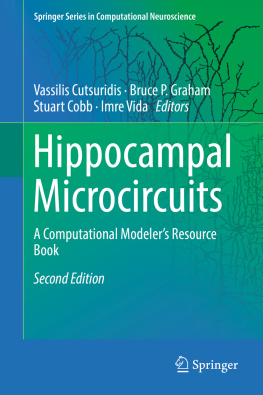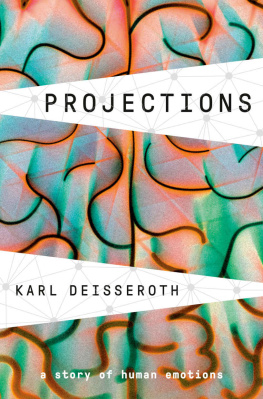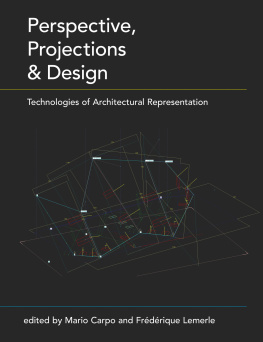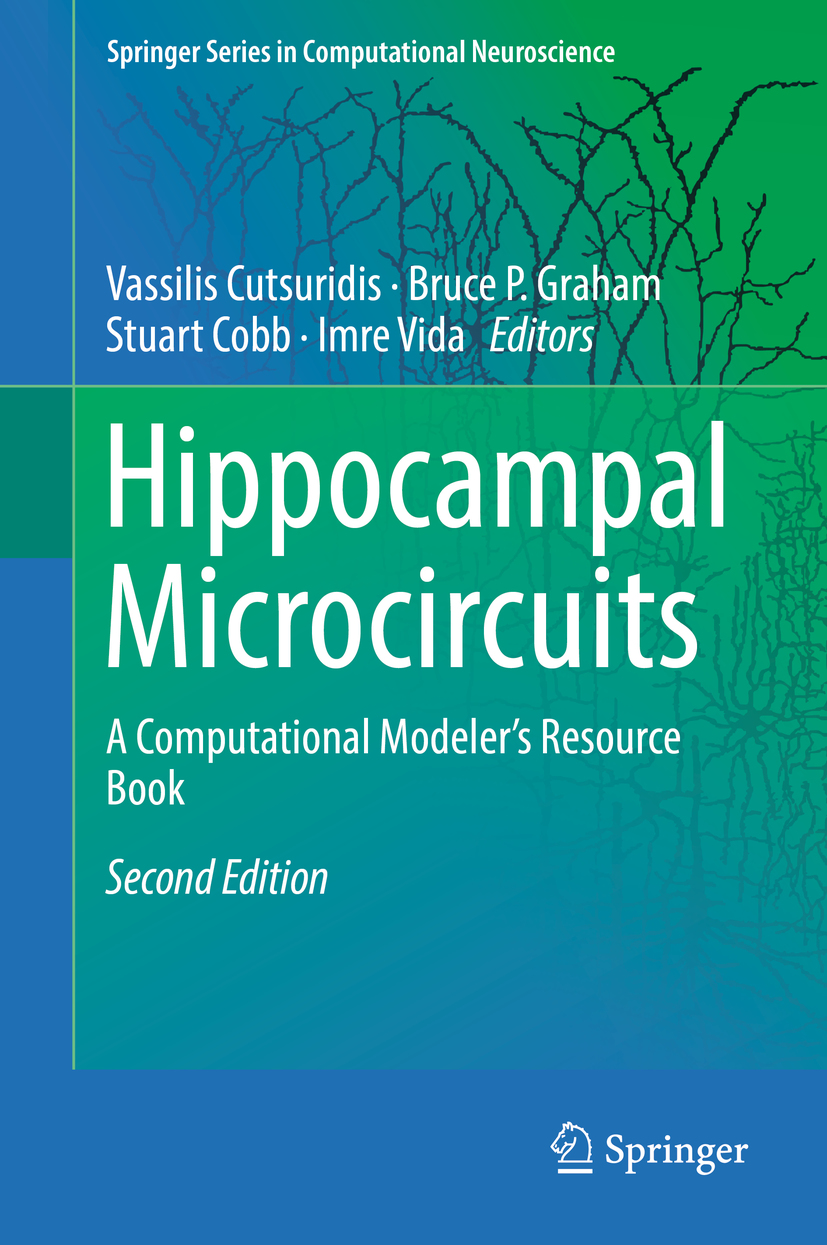Springer Series in Computational Neuroscience
Series Editors
Alain Destexhe
Unit for Neurosciences, Information and Complexity (UNIC), CNRS, Gif sur Yvette, France
Romain Brette
Institut de la Vision, UPMC, CNRS, INSERM, Paris, France
Computational Neuroscience gathers monographs and edited volumes on all aspects of computational neuroscience, including theoretical and mathematical neuroscience, biophysics of the brain, models of neurons and neural networks, and methods of data analysis (e.g. information theory). The editors welcome suggestions and projects for inclusion in the series.
About the Editors: Alain Destexhe is Research Director at the Centre National de la Recherche Scientifique (CNRS), France, and Romain Brette is Research Director at the Institut National de la Sant et de la Recherche Mdicale (INSERM), France.
More information about this series at http://www.springer.com/series/8164
Editors
Vassilis Cutsuridis , Bruce P. Graham , Stuart Cobb and Imre Vida
Hippocampal Microcircuits A Computational Modelers Resource Book 2nd ed. 2018
Editors
Vassilis Cutsuridis
School of Computer Science, University of Lincoln, Lincoln, UK
Bruce P. Graham
School of Natural Sciences, Department of Computing Science and Mathematics, University of Stirling, Stirling, UK
Stuart Cobb
Centre for Discovery Brain Sciences, University of Edinburgh, Edinburgh, UK
Imre Vida
Institute for Integrative Neuroanatomy, Charit Universittsmedizin Berlin, Berlin, Germany
ISSN 2197-1900 e-ISSN 2197-1919
Springer Series in Computational Neuroscience
ISBN 978-3-319-99102-3 e-ISBN 978-3-319-99103-0
https://doi.org/10.1007/978-3-319-99103-0
Library of Congress Control Number: 2019930148
Corrected Publication 2019
Springer Nature Switzerland AG 2018
This work is subject to copyright. All rights are reserved by the Publisher, whether the whole or part of the material is concerned, specifically the rights of translation, reprinting, reuse of illustrations, recitation, broadcasting, reproduction on microfilms or in any other physical way, and transmission or information storage and retrieval, electronic adaptation, computer software, or by similar or dissimilar methodology now known or hereafter developed.
The use of general descriptive names, registered names, trademarks, service marks, etc. in this publication does not imply, even in the absence of a specific statement, that such names are exempt from the relevant protective laws and regulations and therefore free for general use.
The publisher, the authors, and the editors are safe to assume that the advice and information in this book are believed to be true and accurate at the date of publication. Neither the publisher nor the authors or the editors give a warranty, express or implied, with respect to the material contained herein or for any errors or omissions that may have been made. The publisher remains neutral with regard to jurisdictional claims in published maps and institutional affiliations.
This Springer imprint is published by the registered company Springer Nature Switzerland AG
The registered company address is: Gewerbestrasse 11, 6330 Cham, Switzerland
The original version of this book was revised. The correction to this chapter is available at
Introduction
Vassilis Cutsuridis
Bruce P. Graham
Stuart Cobb
Imre Vida
The hippocampus is amongst the most widely studied of mammalian brain regions hypothesized to play a role in the short-term storage of declarative memories. Recent years have witnessed a dramatic accumulation of knowledge about the morphological, physiological and molecular characteristics as well as the connectivity and synaptic properties of the various cell types found in the hippocampus. The microcircuits these cells form exhibit different rhythmic states such as theta (47 Hz) and gamma (30100 Hz) oscillations in different behavioural conditions. This dynamic complexity presumably corresponds to specific functional processing of information. Much work has been devoted to trying to understand the cellular and network properties that generate these and other complex network patterns, but much is still to be done to decipher the function of the detailed microcircuits.
Microcircuits can be thought as functional modules that act as elementary processing units bridging the gap between single-cell activity, network activity and global brain function. Microcircuits can be found in many parts of mammalian nervous systems consisting of a complex architecture involving many different neuronal types connected in feedforward and feedback loops. Synaptic connections may be excitatory or inhibitory and target specific spatial compartments of a neuron. In addition to synaptic input, a neuron and the microcircuit it is a part of are subject to diffuse neuromodulatory signals. Neural synaptic transmission and neuromodulation combine to provide a complex dynamics of neural activity and presumed information processing in a neuronal microcircuit.
This book is the second edition of the 2010 Hippocampal Microcircuits and provides an updated snapshot and resum of the current state of the art of the ongoing research avenues concerning the hippocampal microcircuits. The central aim of the volume is to provide a methodology to anyone interested in developing microcircuit-level models of the hippocampus. The book is divided into two thematic areas: (1) experimental background and (2) computational analysis. In the first thematic area, leading experimental neuroscientists discuss the morphological, physiological and molecular characteristics as well as the connectivity and synaptic properties of the various cell types found in the hippocampus. Behaviour-related ensemble activity patterns of morphologically identified neurons in anaesthetized and freely moving animals provide insights on the function of the hippocampal areas. In the second thematic area, computational neuroscientists present models of hippocampal microcircuits at various levels of detail (e.g. single-cell level, network level). These models make use of the knowledge presented in the first thematic area to discuss the overall global function of hippocampal microcircuits (in areas CA1, CA3, dentate gyrus and entorhinal cortex). Synaptomics and connectomics models of hippocampal structures are initially discussed. Then, network models of memory, rhythm generation and spatial navigation are presented, followed by abstract and biophysical models of synaptic plasticity. Network models of hippocampal implicated disorders (epilepsy and schizophrenia) are then detailed and how their network topologies, connectivities and activities change in these diseases. Finally, two chapters are dedicated to describing simulator environments of single neurons and networks currently used by computational neuroscientists in developing their models and modelling tools to parametrically constrain them.
This engaging volume is invaluable to experimental and computational neuroscientists, electrical engineers, physicists, mathematicians and others interested in developing microcircuit models of the hippocampus. Graduate-level students and trainees in all of these fields will find this book a significant source of information. The following unique features make this volume distinct:













